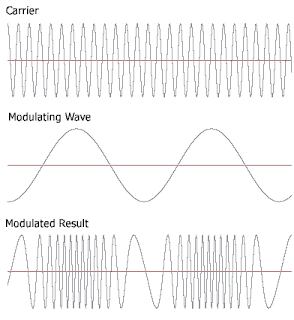In telecommunications, frequency modulation (FM) conveys information over a carrier wave by varying its frequency.In a frequency modulated system,the amplitude of the modulated carriers kept constant,while its frequency is varied in accordance with the variations of the modulating signal. . Main advantages of PM are improved signal to noise ratio and less radiated power.
The carrier signal is represented by
c(t) = A cos( wc t)
The modulating signal is represented by
m(t) = B sin( wmt)
Then the final modulated signal is
A cos( wc t + m(t)) = A cos( wc t + B sin( wmt))
Because of demodulation reasons, the frequency of m(t) is always kept much smaller than that of the carrier signal.
FM is commonly used at VHF radio frequencies for high-fidelity broadcasts of music and speech. Normal (analog) TV sound is also broadcast using FM. The type of FM used in broadcast is generally called wide-FM, or W-FM. In two-way radio,narrow band narrow-fm (N-FM) is used to conserve bandwidth. In addition, it is used to send signals into space. FM is also used at intermediate frequencies by all analog VCR systems, including VHS, to record both the luminance (black and white) and the chrominance portions of the video signal. FM is also used at audio frequencies to synthesize sound. This technique, known as FM synthesis, was popularized by early digital synthesizers and became a standard feature for several generations of personal computer sound cards.
The original waveform of the FM are given below:

No comments:
Post a Comment